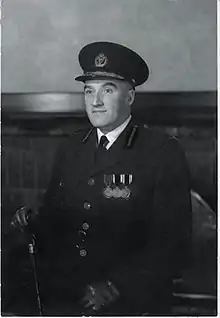Alexander Duncan (police officer)
Alexander Mitchell Duncan CMG (25 September 1888–1 September 1965) was a Scottish-Australian police officer. Duncan was Chief Commissioner of Victoria Police from 1937 to 1954.[1]
Alexander Duncan | |
|---|---|
 | |
| 11th Chief Commissioner of Victoria Police | |
| In office 1937–1954 | |
| Preceded by | Thomas Blamey |
| Succeeded by | Selwyn Porter |
| Personal details | |
| Born | Alexander Mitchell Duncan 25 September 1888 Mortlach, Banffshire, Scotland |
| Died | 1 September 1965 (aged 76) Brighton, Victoria, Australia |
| Nationality | Scottish-Australian |
| Occupation | Police officer |
Britain
Duncan was born in 1888 in Mortlach—a town in Banffshire in northern Scotland. His father, John, was a farmer and his mother, Elizabeth, née Mitchell.[1]
After completing his education in Dufftown, Duncan moved to London where he joined the Metropolitan Police in 1910. He served with the Metropolitan Police for 26 years; most of his work with the Criminal Investigation Department. Duncan rose to the rank of Chief Inspector and in 1935 was given command of the "Flying Squad".[1]
Australia
In 1936, Duncan was seconded to the state government of Victoria to inspect and report on the Victoria Police Force. The appointment was made by Premier of Victoria Albert Dunstan on the advice of the Metropolitan Police Commissioner Sir Philip Game—a former Governor of New South Wales. Dunstan ordered the inspection after the controversial resignation of the previous Chief Commissioner Thomas Blamey amid public allegations of widespread corruption within the force.[1]
Duncan presented two reports to the Victorian government which recommended a range of reforms, including detective training and the use of forensic science and changes to the promotion system and the deployment of personnel. The recommendations were accepted by the government who then appointed Duncan to the position of Chief Commissioner "with a mandate to introduce the reforms".[1]
Once appointed, Duncan began the task of dealing with "entrenched bad practice, poor leadership, maladministration and corruption.[2] Duncan made some headway in his term but was unable to address these problems immediately.[2] Duncan retired from Victoria Police in 1954.[1]
Private life
Duncan married Elizabeth Ann MacDonald on 1 September 1917 at Trinity Presbyterian Church, Lambeth, with whom he had one daughter.[1] Duncan was active in the "Boy Scouts' Association, Melbourne Rotary, YMCA, the Royal Humane Society, the National Fitness Council and the State Relief Committee."[1] He died in Brighton, a suburb of Melbourne, in 1965.[1]
Honours and awards
![]()
![]()
![]()
![]()
![]()
![]()
| Companion of the Order of St Michael and St George (CMG) | 1 January 1946 | In recognition of service as Chief Commissioner of Police in Victoria.[3] | |
| Officer of the Order of St John | 7 January 1955 | [4] | |
| King George V Police Coronation Medal | 22 June 1911 | ||
| King George V Silver Jubilee Medal | 6 May 1935 | ||
| King George VI Coronation Medal | 12 May 1937 | [5] | |
| Queen Elizabeth II Coronation Medal | 2 June 1953 | [6] |
References
- Haldane, Robert (1996). "Duncan, Alexander Mitchell (1888–1965)". Australian Dictionary of Biography. Melbourne University Press. ISSN 1833-7538. Retrieved 12 December 2012 – via National Centre of Biography, Australian National University.
- Past Patterns, Future Directions: Victoria Police and the problem of corruption and serious misconduct. Melbourne: Office of Police Integrity. 2007.
- Australian Government, Department of the Prime Minister and Cabinet. "Alexander Mitchell Duncan". It's An Honour. Retrieved 14 April 2020.
- "No. 40378". The London Gazette. 7 January 1955. p. 159.
- "CORONATION MEDALS FOR 2,000 VICTORIANS". Argus (Melbourne, Vic. : 1848 - 1957). 1937-05-12. p. 11. Retrieved 2020-04-27.
- "CORONATION MEDALS FROM THE QUEEN". The Argus (Melbourne). 2 June 1953. p. 13. Retrieved 27 April 2020.
| Preceded by Thomas Blamey |
Chief Commissioner of Victoria Police 1937–1954 |
Succeeded by Selwyn Porter |